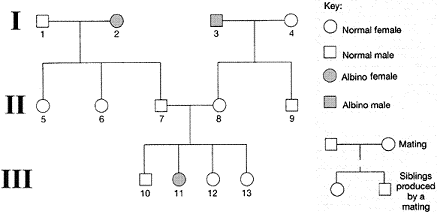Which of the following would be characterized as a juxtacrine signal?
A) contact-dependent
B) endocrine
C) self-responding
D) distal neighbors
E) both choices B and D
A) contact-dependent
You might also like to view...
The extracellular matrix (ECM) affects a cell that it surrounds in which ways? (Select all correct choices.)
A. The ECM affects the shape that the cell takes, depending on the structure and composition of the extracellular matrix. B. The ECM affects the genes that the cell expresses, depending on the types of fibrous proteins in the extracellular matrix. C. The ECM affects the size that the cell grows to, depending on the polysaccharides in the extracellular matrix. D. The ECM has no effect on the cells that it surrounds. E. All of these choices are correct.
Refer to the accompanying figure. Based on the phenotypes of the third generation, the genotype of the father in the second generation must be:

a. homozygous for albinism.
b. heterozygous for hair color.
c. heterozygous for albinism.
d. X-linked.
e. dominant
What type of organism possesses multiple sets of chromosomes from different species?
a. a polygamete b. an allopolyploid c. an autopolyploid d. a hybrid polyploid e. a heterozygous polyploid
Some of your DNA may not code for any protein and has no known function in gene regulation; it is sometimes referred to as noncoding DNA. How do nucleotide sequences of "noncoding DNA" evolve?
A) They evolve through natural selection. B) They evolve through genetic drift and other chance processes. C) They evolve to be more useful by taking on new functions. D) They evolve by gradually being eliminated from the gene pool.